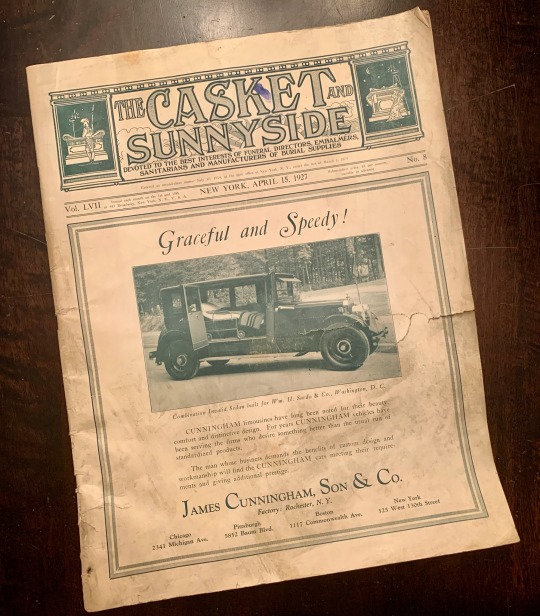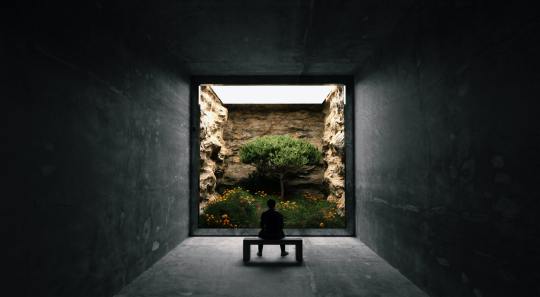#deathcare
Text
For that little funeral director in training



#little tykes#funeral director#mortician#funeral#dead#morbid#undertaker#deathcare#funeral home#cremation#embalmer
2K notes
·
View notes
Text
At almost any location in any major city on Earth, you are likely standing on thousands of bodies. These bodies represent a history that exists, often unknown, beneath our feet. While a new Crossrail station was being dug in London in 2015, 3,500 bodies were excavated from a sixteenth- and seventeenth-century cemetery under Liverpool Street, including a burial pit from the Great Plague of 1665. To cremate bodies we burn fossil fuel, thus named because it is made of decomposed dead organisms. Plants grow from the decayed matter of former plants. The pages of this book are made from the pulp of raw wood from a tree felled in its prime. All that surrounds us comes from death, every part of every city, and every part of every person.
Death avoidance is not an individual failing; it’s a cultural one. Facing death is not for the faint-hearted. It is far too challenging to expect that each citizen will do so on his or her own. Death acceptance is the responsibility of all death professionals—funeral directors, cemetery managers, hospital workers. It is the responsibility of those who have been tasked with creating physical and emotional environments where safe, open interaction with death and dead bodies is possible.
— From Here to Eternity: Traveling the World to Find the Good Death, Caitlin Doughty
#dead man's bones#death avoidance#death acceptance#Caitlin Doughty#Ask a Mortician#From Here to Eternity: Traveling the World to Find the Good Death#From Here to Eternity#books#bookblr#death positive#death positive movement#nonfiction#science#history#travel#anthropology#memoir#sociology#atypicalreads#deathcare#cw death
139 notes
·
View notes
Text


30 notes
·
View notes
Text


#mortuary science#mine#aesthetic#embalming fluid#scissors#mortuary#mortician#funeral science#funeral director#grunge#death care#deathcare#women in stem
2 notes
·
View notes
Text
Hey How Are You?
Cause i'm not doing great.
I don't really know why I started this one other than to rant into the void about being a deathcare worker and all the baggage that entails.
So I should probably introduce myself.
Hi, my name is Cait. I'm a licensed funeral director and embalmer, and of all the many names for what I do, I prefer mortician. I've been in deathcare for just about five years. I went back to school in 2018 to get my degree in Mortuary Science, and after a couple short apprenticeships, really started working just about 3 months before Covid hit in 2020.
I've worked as a removal tech, a night-shift embalmer, a trade embalmer, a funeral director, a crematory operator, and I am currently working as a funeral director/embalmer/natural organic reduction operator. At least, those are the licenses I currently have.
What I actually do most days is funeral directing- which is an amorphous, incredibly frustrating, sometimes deeply satisfying, always exhausting field to be in.
Because funeral directors aren't just funeral directors. We're also corpse wranglers/accountants/the IT department/unofficial therapists/officiants/party planners/babysitters/record keepers/scapegoats/family mediators/servants. Some folks work for big companies where they only have three or four of those jobs, but I can promise you that no one in this industry is ever just doing one thing.
I'm also a comic artist (not ha ha comic but paper comic), so I make a lot of comics about deathcare and what it means. I'm a nerd, so I read a lot of books about grief and philosophy and how our brains work. People always seem to want to interact with my comics about what I do, so I figured I would keep making them, and start writing about a lot of the things we do as well. I want to make our current culture less death-phobic and more proactive about what they can do to maintain their autonomy even after they're gone.
I also want to talk about what it means to work in this industry (because it is an industry, and often it can feel like working in a bleak, Orwellian factory from a future without color) and what effect it has on the people who care enough to make it their lives. There's a reason people burn out of this line of work quickly and often. We don't take care of the people who take care of our dead, and that's a huge problem.
So that's it, I guess. I wanna scream into the void about all that stuff, so I will. You're welcome to join me if you'd like.
#death#deathcare#death care#mortician#funeral director#mortuary science#mental health#burnout#comics#rambling
5 notes
·
View notes
Quote
If medicine is business, and care is the commodity, actualized health impedes the profitability of morbidity.
Zisa Aziza
#Truths89#medicine#healthcare#deathcare#morbidity#profit#metrics#care looters#distrusting#self determination#self accountability#holistic health#intermentient#intermittentfasting#herbs#movement#NegressOfSaturn#ZisaAziza#conartist#medicalscammers
6 notes
·
View notes
Text
Been Gone a LONG Time;
But I did it! I graduated from mortuary school! So proud of myself, my husband, our son. They all helped me, and I did it <3
#deathcare#mortician#funeral services#witch community#witchcraft#celtic#celticpaganism#greenwitch#kitchenwitch
20 notes
·
View notes
Text

There’s a magazine for just about every trade. This is one of them. The Casket and The Sunnyside used to be competing magazines but they must’ve merged at some point in history. There was a third one, The Weekly Shroud, but I don’t know much about it except for the title.
I first read about these in the photo/illustration credits of Charles Addams’ Dear Dead Days (1959) and now I finally tracked one down for myself!
4 notes
·
View notes
Text
Wabi-sabi: Embracing the Beauty of Imperfection and Impermanence

In a world that often glorifies perfection and eternal youth, the Japanese aesthetic of Wabi-sabi offers a refreshing perspective on beauty and impermanence. Wabi-sabi is a philosophy that values simplicity, humility, and the acceptance of imperfection, impermanence, and transience. It is a celebration of the natural cycle of birth, growth, decay, and death, and a recognition that everything is constantly changing and evolving.
At the heart of Wabi-sabi is the idea that imperfection can be beautiful and that there is a certain elegance in things that are worn, weathered, and imperfect. For example, Kintsugi, the practice of visibly mending a cracked and chipped teacup with rare metals makes it more valuable and desirable than a flawless one - each holding a unique character and history. Wabi-sabi emphasizes the importance of the present moment and the fleeting nature of life, encouraging us to savor the beauty and richness of each passing moment.
Impermanence is a key concept in Wabi-sabi. It reminds us that nothing lasts forever and that all things are subject to change and decay. This can be a difficult concept for some to truly digest, as it challenges our desire for control and stability. However, by embracing impermanence, we can learn to let go of lingering attachments and appreciate the beauty of the present, knowing that a moment is precious and will not last forever.
The impermanence of life is constantly reflected in the natural world, where everything is constantly changing and evolving. The changing seasons, the growth and decay of plants, and the cycle of birth and death are all reminders of the transience of life. In Wabi-sabi, nature is seen as a source of inspiration and beauty, and its imperfections are celebrated as part of its inherent beauty.
Wabi-sabi can be applied to all aspects of life, from art and design to personal relationships and daily routines. It encourages us to find beauty in the simple and ordinary, to appreciate the uniqueness of each moment, and to embrace the imperfections and impermanence of life. By doing so, we can cultivate a sense of peace and contentment, and find joy and meaning in the present moment.
Life After Life parks embody Wabi-sabi philosophy in offering an alternative to the traditional cemetery culture of perfection and permanence that dominates our modern world. By embracing the beauty offered by natural imperfection and impermanence, we can find opportunity and purpose in the transient nature of life. We can learn to appreciate our moment here as a beautiful snapshot in a greater story. A story that began before us and will continue after we are gone. Wabi-sabi reminds us that beauty lies not in irrational attempts at preservation, but in the changes and quirks that make our moment here unique and special.
#life after life#wabi sabi#imperfection#impermanence#deathcare#greenburial#sustainability#sustainable living#conservation#transcend#think longer term#one last good deed
5 notes
·
View notes
Text

Some of my favorite mortuary art of all time.
🖌 Boneface
83 notes
·
View notes
Text
The mummies, still on display, did not have the same confronting effect on Sarah. She turned a dark corner and stopped in front of the mummified body of a small baby girl, dressed in white and lying on velvet. “She looked like an angel with this halo of light around her, and I swear that in that moment I felt like I could stand there forever and just look at her.”
Another woman noticed Sarah’s silent tears and went to get her a tissue, quietly holding her arm.
Other child mummies in the museum had their own props, such as scepters and crowns. These were the Angelitos, or Little Angels. Prior to the mid-twentieth century in Mexico and elsewhere in Latin America, a dead baby or child was considered a spiritual being, almost a saint, with a direct audience with God. These Angelitos, free from sin, could offer favors for the family members they left behind.
The godmother would prepare the body, washing and dressing it in the garb of a pint-sized saint, and surround it with candles and flowers. The mother wouldn’t see the corpse until after this process, at which point the body had relinquished the burdens of grief, transformed into a heavenly being ready to take its place by God’s right side.
Friends and family were invited to the party, not only to honor the child but also to impress and gain its favor; remember, it now possessed great spiritual power. Sometimes the child was even carried from party to party, with other children acting as the pallbearers, with the parents and family in procession. Often the Angelito was photographed or painted amid a brilliant tableau.
For Sarah, though she holds no belief in the saints or the afterlife, it was the recognition of the child’s death that moved her. “These children were treated as so special. Something was done just for them,” she said. There were parties and paintings and games and, most of all, tasks to perform for the child—tasks beyond the lonely, interminable silences.
— From Here to Eternity: Traveling the World to Find the Good Death, Caitlin Doughty
#Angelitos#Caitlin Doughty#Ask a Mortician#From Here to Eternity: Traveling the World to Find the Good Death#From Here to Eternity#books#bookblr#death positive#death positive movement#nonfiction#science#history#travel#anthropology#memoir#sociology#atypicalreads#deathcare#cw death#mexico#long post
43 notes
·
View notes
Text
This week, Jem and Red give some personal background about themselves. How did they get into the crazy world of deathcare and what is it, exactly, that they do?
God this this podcast is SO GOOD!
These co-hosts are so cool. These young death care people are just such a fresh and fun pair of people.
They make death so much less morbid and less scary. And such a good fun light podcast. And so neat and deep.
I don't usually gush hard on podcasts, but this one is so fucking fun!
Book(s) mentioned in podcast:
#mortuary science#deathcare#funeral industry#funeral homes#trocar#mortmic#death#coffin#casket#podcast#funeral#cremation#embalming#crematorium#embalming fluid#ask a mortician#interesting#cause of death#corpse#morgue#medical examiner#Crime Scene Investigator#Mary Roach#cadaver#Caitlin Doughty#funeral home#cemetery#graveyard#autopsy#funeral director
14 notes
·
View notes
Text
youtube
LORNA SHORE - Pain Remains III: In a Sea of Fire (OFFICIAL VIDEO)
Taken from the Album "Pain Remains", Out October 14th, 2022
https://lornashore.lnk.to/PainRemainsID
Director, Cinematography, Editor, Post-Production Effects
David Brodsky for MyGoodEye : Music Visuals
Producer, Cinematography, Editor
Allison Woest for MyGoodEye : Music Visuals
Song Production/Mixing/Mastering
Josh Schroeder for Random Awesome Studios
Lighting Director
Adam Pernick
Assistant Director
Robb Brown
Grip/Electric
Lindsey Fehr
Led Wall Tech, Add'l Lighting
Matt Kester
Justin Goreschak
Kyle Johnson
Screenplay Written by
Adam De Micco
Production Assistants
Zach Jabine
Sean Santiago
Giovani Shirley
Denny Tats
Chris Lloyd
Robert Fell
Joseph Tocco
Location Manager
Josh Balz
Rob Hunt
Chris Merrillo
Starring
Peter Welch
Laura Newman
Brian Feist
With
Holly Cieczko
Jill Crawford
Matt Jenkins
Shawna Kester
Thomas Knott
Pink Lloyd
Brandon Ossint
Carmen Randazzo
Eric Ross
Christina Vazquez
Teresa Whitehouse
LYRICS:
Cursed by this apparition
Destined to take its place
A ceaseless existence born of my dream state
Manifested and pressed into sand
You’ve long been cemented
Distracted, impacted by the weight of the world
If this is everything then
I don‘t want to cut the swathe
Let the flames rise and bury me within this fog,
An echo, a murmur -
A broken melody
I let go of my life but you were just a dream
I’ll throw myself into the fire and burn away
Ridding this flesh of burden and pray I suffocate
I’ll salt the earth in this crimson blaze
This world will burn in my fall from grace
Witness the death of God
Hear the devil‘s choir as I leave the stage
in a sea of fire
If this is all I am then what’s the point
of pacing life
Everything that I made became a waste of time
Expressive, depressive
I‘m caught up in a lie
Decisive, enticive
I’d rather fucking die
I’ll damn this world to a sea of flames
Forsake the ground and let it bury me
You were nothing but a shackle
Now I can breathe
Let this fire rain down and bury me in a sea of flame
Forsake the ground the let it bury me
Let this fire rain down and damn this world
Fuck this existence
Bring me back to where it all began in the fall
Wake me up before i lose it all
This is my epilog - my soliloquy
Take this broken melody straight to the grave
Dancing like flames
After all that I’ve done
I’ll salt the earth and disappear in a sea of fire
Note: "Pain Remains" is definitly in my top 100 records of 2022 list and I'm sure at some point we will look back at this lineup as we look at the days when Ronnie James Dio was in Black Sabbath.
5 notes
·
View notes
Text

Finished this one today. It was a hybrid read since I also was listening to the audiobook while driving to and from work as well. I liked it; definitely learned about a couple deathcare things I didn't know. Good ⭐️⭐️⭐️.
#reading#books#deathcare#from here to eternity#caitlin doughty#pendentiveloverblog#books and libraries#my reading list
0 notes
Text
The only thing that's aspirational about the expanse is the human composting, really
1 note
·
View note